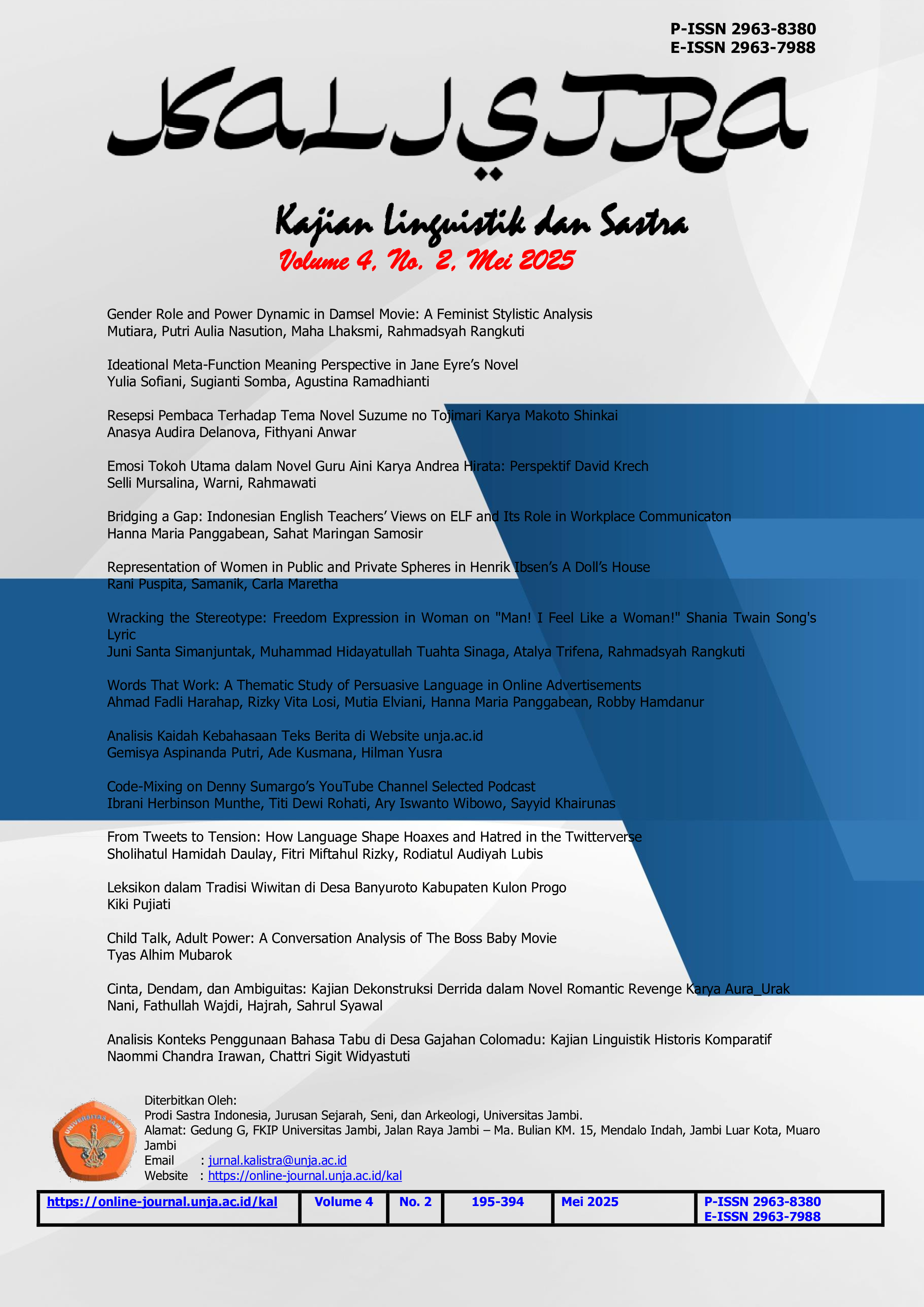From Tweets to Tension: How Language Shape Hoaxes and Hatred in the Twitterverse
DOI:
https://doi.org/10.22437/kalistra.v4i2.43702Keywords:
hoax, language, social media, TwitterAbstract
Language is a primary tool for human communication, and influencing the thoughts and behaviors of others. In the context of social media platforms such as Twitter, language plays a highly strategic role, not only as a medium for personal expression but also as a powerful channel for the wide dissemination of information. One of the most concerning misuses of language in this sphere is the spread of hoaxes false or misleading information that is deliberately constructed to appear truthful, often with specific intentions such as deception, provocation, or incitement of division. This article examines how language is employed to construct and reinforce the narratives of hoaxes and hate speech on Twitter, focusing on lexical choices, rhetorical style, and the emotional appeals embedded in the language. often provocative, manipulative, and designed to elicit strong emotional reactions from audiences. It reveals that hoaxes and hate speech on social media frequently utilize linguistic techniques such as excessive generalizations and inflammatory diction to create tension and sow division within society. The impact of such phenomena extends beyond the digital realm, potentially triggering real-world social conflicts. Through a linguistic and media studies approach, this article aims to uncover the patterns of language used in the dissemination of disinformation and hate, while encouraging readers to adopt a more critical, mindful, and responsible attitude toward language use on social media platforms.
Downloads
References
Fauzi, A. (2021). Language and Polarization: A Twitter Discourse Study in Social Conflict. Journal of Media Studies, 6(2), 120–135.
Daulay, SH., (2019). Language and Society. Medan: Lembaga Peduli Pengembangan Pendidikan Indonesia (LPPPI). ISBN. 978-623-90653-3-1
Daulay, S. H., Bahar, T., Putri, A., & Batubara, P. F. (2023). Various wordings of propaganda on social media: Cases from Instagram application. Journal of Linguistics, Literacy, and Pedagogy, 2(2), 100-107.
Daulay, S. H., Nst, A. H., Ningsih, F. R., Berutu, H., Irham, N. R., & Mahmudah, R. (2024). Code switching in the social media era: A linguistic analysis of Instagram and TikTok users. Humanitatis: Journal of Language and Literature, 10(2), 373-384.
Daulay, S. H., & Lubis, R. A. (2024). Tweeting Between the Lines: Exploring Code Mixing In The Twittersphere. Jurnal JOEPALLT (Journal of English Pedagogy, Linguistics, Literature, and Teaching), 12(2), 226-236.
Daulay, S. H., & Aulia, D. N. (2024). Understanding the Role of Language on Twitter: From Hashtag to Discourses. EBONY: Journal of English Language Teaching, Linguistics, and Literature, 4(2), 148-156.
Lestari, R. A. (2020). Language and Power Narratives on Social Media: A Critical Discourse Study. Journal of Digital Discourse, 4(1), 45–58.
Moleong, Lexy J. (2017). Metodologi Penelitian Kualitatif (Edisi Revisi). Bandung: PT Remaja Rosdakarya
Putri, F. A., & Suyanto, A. (2020). Emotion and Content Dissemination on Social Media: A Case Study on Twitter. Journal of Communication, 12(2), 156–170.
Rahadi, D. R. (2019). Hoaxes in the Digital Era: Analysis of Causes and Mitigation Strategies. Journal of Communication Research, 20(1), 23–35.
Ramadhani, D., & Sari, N. W. (2022). Hate Speech on Social Media: A Critical Linguistic Analysis on Twitter. Journal of Language and Literature, 15(2), 97–110.
Sari, R., Lubis, A. K., & Daulay, S. H. (2024). Facts and Features of Human Language in Social Media: Interaction and Culture of Alpha Generation. Journal of English Language Teaching, Linguistics, and Literature Studies, 4(2), 108-121.
Siregar, N. (2017). Digital Literacy in the Information Society. Journal of Communication Science, 15(1), 67–78.
Subroto, E. (2018). Language and Social Reality: A Preliminary Study. Journal of Language and Literature, 3(1), 1–10.
Wiranda, A., Alqawwiy, T. A., & Daulay, S. H. (2024). Identifying Swear Words Uttered by Indonesian Gamers on Live Streaming. JALC: Journal Of Applied Linguistic and Studies of Cultural, 2(2), 1-12.
Downloads
Published
How to Cite
Issue
Section
License
Copyright (c) 2025 Sholihatul Hamidah Daulay, Fitri Miftahul Rizky, Rodiatul Audiyah Lubis

This work is licensed under a Creative Commons Attribution-ShareAlike 4.0 International License.
Kalistra: Kajian Linguistik dan Sastra is licensed under Creative Commons Attribution-ShareAlike 4.0 International License.
Authors who publish their manuscripts in Kajian Linguistik dan Sastra agree to the following terms:
1. The copyright in each article belongs to the author.
2. The author acknowledges that Kajian Linguistik dan Sastra reserves the right to be the first to publish under a Creative Commons Attribution-ShareAlike 4.0 International License (Attribution 4.0 International CC BY-SA 4.0).
3. Authors may submit articles separately, arranging for non-exclusive distribution of manuscripts that have been published in this journal to other versions (e.g., delivery to the author's institutional repository, publication into a book, etc.), acknowledging that the manuscript has been first published in Kajian Linguistik dan Sastra.
















